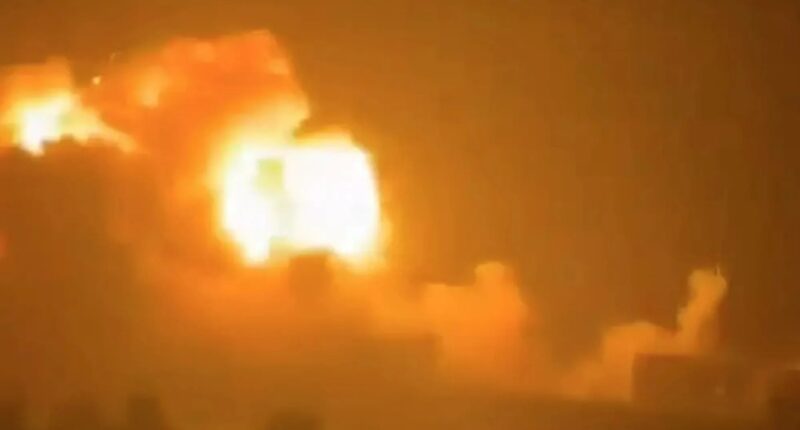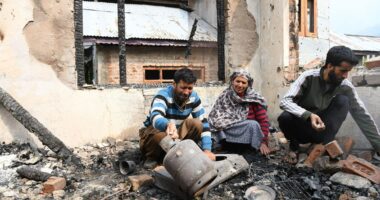INDIA and Pakistan are being urged to step back from armageddon as a nuclear war between the two rivals could kill 125million people.
The fighting neighbours traded rocket and artillery attacks in an overnight blitz leaving dozens dead and fears of all-out conflict.




Pakistan’s leader labelled the strikes an “act of war” and his country claimed to have shot down Indian fighter jets.
Now, fears are abound that fighting could escalate to the use of nuclear weapons and kill tens of millions.
Peace advocates, such as the International Campaign to Abolish Nuclear Weapons, are deeply worried and have urged both parties to de-escalate the situation.
India and Pakistan possess relatively modest supplies of nuclear arms in comparison to countries like Russia and the United States, but their intense rivalry and longstanding conflict over Kashmir heighten concerns.
New Delhi is estimated to have 170 nuclear warheads and can deliver them through land, sea, or air.
Islamabad was last officially thought to also have 170 weapons – but that could have grown that arsenal to around 200.
Colonel Philip Ingram, a former British Army commander, said the West will be particularly nervous about a nuclear conflict.
Ingram noted, “Western intelligence agencies, in particular, will be closely monitoring the preparedness and movement of nuclear weapons within both Pakistan and India to stay abreast of developments.”
“The worrying thing about these two nations is that the tensions are very real.
“The nuclear weapons are not there to protect them against attack from China or Russia or anyone else.
“It’s focused purely on each other.”
Ingram said escalation to using nuclear weapons could happen rapidly and powers like the US would step in to try and prevent their use.
He said: “The US Secretary of State, flying into India and Pakistan, would carry out shuttle diplomacy between the two.”
But that might not be enough to overcome the animosity between the two enemies and their desire to escalate the conflict.
One key rung on the escalation ladder would be troops crossing the border in a wider invasion.
Xiaodon Liang, a Senior Policy Analyst, Nuclear Weapons Policy and Disarmament, at Arms Control Association said the primary concern should be the possibility of a battlefield use escalating to “strategic nuclear exchanges”.
Liang said: “Pakistan has made very clear that it will use nuclear weapons to prevent a full-scale Indian invasion of its territory, and the potential for uncontrollable escalation is part of what makes every crisis between India and Pakistan particularly dangerous.”
BILLIONS COULD DIE
A 2019 academic article predicted how a nuclear war could start between the two countries featuring chilling echoes of what is happening today on the subcontinent.
Following a terror attack in 2025, the authors predict in the Bulletin of the Atomic Scientists that skirmishes would at first erupt before the Indian Army decided to invade Pakistan.
Pakistani generals then panic and decide the only way they could repulse an attack is with nuclear weapons.



At first Pakistan nukes its own territory to wipe out the invading Indian tanks and soldiers.
Sensing a knockout blow, New Delhi decides to launch nukes on Pakistani airfields, army bases, and nuclear weapons depots.
Pakistan responds by nuking Indian naval bases and army garrisons – some in cities – and uses its entire arsenal.
India then fires some 70 nukes on Pakistan, leaving 100 bombs in its arsenal to continue to deter China.
The authors predict up to 125million people would die in the horrifying nuclear exchanges.
But the environmental impacts of some 250 nuclear bombs exploding could kill many more, by creating a global famine.
Billions could be killed as temperatures drop several degrees around the world and a global food shortage hits.
WE’VE BEEN HERE BEFORE
Most experts, including Ingram, think India and Pakistan will choose to deescalate the conflict.
Ingram said: “I think this is something that will blow over relatively quickly, because I think both nations recognize the implications of what’s going on, but that doesn’t mean that the tension is going to simmer down.
“We might see more skirmishes in coming days and weeks.”
Tensions have been simmering for decades and the two countries have been at war at least three times before.


In 2019, India conducted airstrikes on Pakistan after border skirmishes erupted out of Kashmir tensions – but the sides deescalated after that.
India’s Ministry of Defence said the strikes against the camps were in retaliation to a “barbaric” mass shooting in Kashmir last month, when 26 people were killed by gunmen.
A spokesperson said: “These military strikes were designed to deliver justice to the victims of the Pahalgam terror attack and their families.”
In an article for the Atlantic Council, Alex Plitsas assessed strikes so far seemed calculated to allow the other side to save face.
Plitsas said: “By publicly framing the strikes as counterterrorism-focused and avoiding sovereign Pakistani targets, New Delhi sought to limit retaliatory pressure on Islamabad.”
Pakistan has, meanwhile, kept its rhetoric cautious and vowed it has the
The US, China, Britain, and UN have all called for peace.
US Secretary of State Marco Rubio said in a post on X: “I echo @POTUS’s comments earlier today that this hopefully ends quickly and will continue to engage both Indian and Pakistani leadership towards a peaceful resolution.”
CONFLICT COULD HELP CHINA
Ingram said the conflict risks pushing Pakistan into the arms of the “Axis of Evil” – the alliance between Russia, China, Iran, and North Korea.
Ingram said: “It wouldn’t surprise me if we’re seeing Pakistan supplying some capability to Russia.”
Ingram said China could use the conflict as a way of testing its weapons on the battlefield to prepare for an invasion of Taiwan.
He said: “China could stimulate a refocus of Western attention, you know, back to Pakistan, India, possibly North and South Korea, while China is focusing on Taiwan.
“China would love to do that. It’s within their playbook. It’s the sort of tactics they’d use.”
Pakistan would likely not start sending weapons to support Russia’s invasion of Ukraine as it needs to stockpile ammunition and guns for its own battles.
Ingram said: “But I think we’ll see closer relations building up, and they could come into this grouping that we are loosely referring to as the axis of evil.
“And it’s worrying that continues to grow.”
What is the Kashmir conflict about?

The region of Kashmir has always been a contentious issue even before India and Pakistan won their independence from Britain.
But the current conflict stems from how the region was split up as the two countries were gaining independence.
Indian troops took two-thirds of Kashmir, while Pakistan seized the northern third.
Since then, two wars have been fought between the two countries and the row has developed into one of the most intense geopolitical rivalries on earth.
There are about 16 million people in Kashmir, split between the Indian-controlled and Pakistani-controlled zones.

















